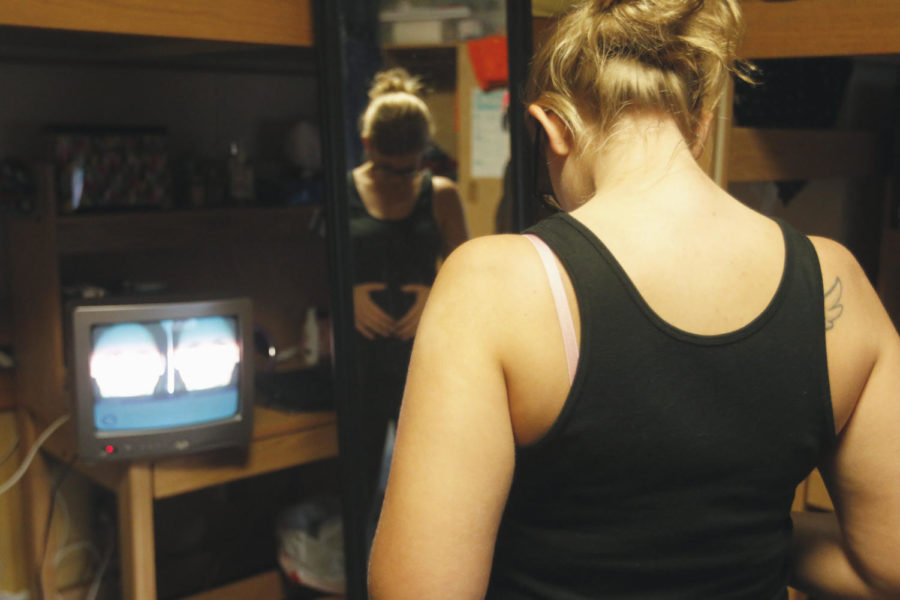Wandschneider: Media’s influence on body image
Hayley Hochstetler/Iowa State Daily
Nearly 91 percent of all women are unhappy with the appearance of their bodies. Adolescent girls aspire to look like celebrities or models, which have nearly impossible waist sizes, silky hair and flawless complexions — none of which are realistically achievable for the average person.
September 24, 2013
We all know that the media is everywhere. It influences us to buy certain products or to vote for a certain political candidate. What we don’t all know is that the media is a main accomplice of the negative ways women view their bodies.
Nearly 91 percent of all women are unhappy with the appearance of their bodies. To try and resolve this, many turn to dieting, which can progress into pathological dieting, so they can work toward achieving the ideal body image set by our culture. Many of these pathological dieters develop some type of eating disorder, such as anorexia or bulimia.
Teenage girls are dying to be thin, literally. Twenty million women suffer from some type of eating disorders during their lifetime. Of all mental illnesses, eating disorders have the highest mortality rate. This destructive disease is all rooted back to one culprit — a low self-esteem due to harmful media exposure.
We live in a day and age where adolescent girls cannot even look at a cover of a magazine without being bombarded with unrealistic photographs of celebrities supposedly possessing the perfect body. They have nearly impossible waist sizes, silky hair and flawless complexions – none of which are achievable for the average person.
Once past the cover, the magazine’s pages are plastered with models that are supposed to represent what is beautiful. In reality, only 5 percent of women naturally possess the “ideal body” that the American media portray as attractive. However, young subscribers to fashion magazines rarely recognize the fact that those models don’t naturally look like that. The models undergo extreme dieting and the magic of Photoshop to gain their well-known appearances.
In 2009, Ralph Lauren released an ad that spiked much controversy between fashion and body image. In the advertisement, the model appeared to have a significantly smaller waist than the size of her head. It was a Photoshop mishap that occurred when the company decided that model’s size 4 figure was too big. So, they used technology to have their model fit the “ideal customer.”
Even though Ralph Lauren apologized for the incident, it is evident that advertisers everywhere will use toxic tactics so they can promote that the people who should wear their clothes should be thin.
We are pressured to believe that being skinny and beauty go hand in hand. Abercrombie and Fitch CEO Mike Jeffries mentioned that he only wanted “attractive, thin” people to be wearing his clothes and that his company was exclusive. We need to ask ourselves whose right it is to decide the requirements to wear a certain brand of clothes. It is people like Jeffries who are poisoning the minds of the younger generations.
Abercrombie and Fitch doesn’t even sell shirts bigger than a size large. Even then, a large is much smaller than what most retailers have labeled as such. The ridiculously unrealistic sizes retailers use contribute to the negative influences of the media.
Instead of the media praising this behavior, they should be encouraging that a healthy body coincides with beauty. The company Dove took and in 2004, The Dove Campaign for Real Beauty was launched.
The women who appeared in their ads didn’t fit the stereotypical models that are usually used in advertisements; these women had curves. The ads encouraged women to embrace their inner beauty and see that each woman is beautiful in her own way. Using media exposure in a positive way, Dove is allowing women to see what true beauty looks like.
Like many female college students, I love to read a good fashion magazine. There is something relaxing about flipping through the slick, glossy pages and inhaling the different designer perfume samples.
While scanning through the clothing ads, I can’t help but stop and wish that I had a certain body type so I could wear those styles. I think, “maybe if I was that skinny I could wear the ‘cool’ brands and be considered popular among my peers.”
Flip through a few more pages and you find exercise plans to help you get that bikini body in six weeks, which is very unlikely to happen. The magazines suck in targeted victims, making them think those images are how they are supposed to look. Readers don’t realize that media are impacting them until it is too late.
The media are powerful things that influence millions, for better or worse. In this case, they are allowing young girls to feel that in order to be pretty, they need to be thin. Maybe if more companies used the power of media to show that being healthy is the new thin, we wouldn’t have so many people struggling with body image.







